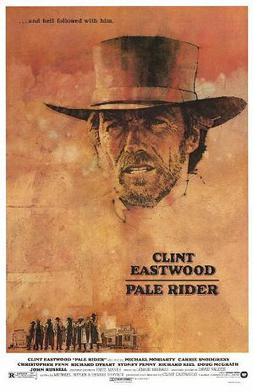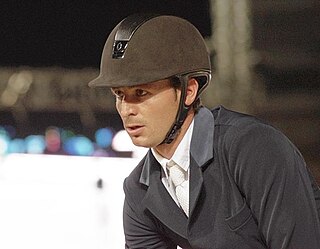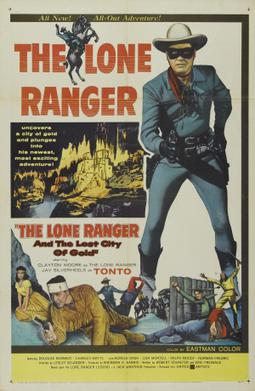
The Four Horsemen of the Apocalypse are figures in the Book of Revelation in the New Testament of the Bible, a piece of apocalypse literature written by John of Patmos. They are not specifically identified there but subsequent commentary often identifies them as personifications of Death, Famine, War, and Conquest.

Pale Rider is a 1985 American Western film produced and directed by Clint Eastwood, who also stars in the lead role. The title is a reference to the Four Horsemen of the Apocalypse, as the pale horse's ghost rider (Eastwood) represents Death. The film, which took in over $41 million at the box office, became the highest-grossing Western of the 1980s.

The Spanish Riding School is an Austrian institution dedicated to the preservation of classical dressage and the training of Lipizzaner horses, based in Vienna, Austria, whose performances in the Hofburg are also a tourist attraction. The leading horses and riders of the school also periodically tour and perform worldwide. It is one of the "Big Four", the most prestigious classical riding academies in the world, alongside the Cadre Noir, the Portuguese School of Equestrian Art, and the Royal Andalusian School.
Equestrian competitions at the 1968 Summer Olympics in Mexico City, Mexico featured team and individual competitions in show jumping, eventing, and dressage. Mexico City proved a challenging site since it was 2,300 meters above sea level, resulting in 30% less oxygen in the air. The horses at the 1955 Pan American Games, which was also held in Mexico City, arrived a few weeks before the Games to adjust, but had difficulty in the competition. However, racehorses that competed at the same location and who were shipped in the day before, and left the day after the race, performed fine. It was discovered that although horses would adjust immediately to the high altitude during the first few days after arrival, they showed weakness and decreased performance around Day 10, which continued to Day 20. Therefore, nations were advised to ship in horses 3–4 weeks before the competition, which would allow them time to recover from the long travel, as well as adjust to the difference in altitude. Argentina, Ireland, and the USSR were the first to ship horses over, who arrived mid-September. France and Germany were the last countries to send their horses, who arrived 28 September 20 days before the competition was to start.

The equestrian events at the 1936 Berlin Summer Olympics included dressage, eventing, and show jumping. All three disciplines had both individual and team competitions. The host country, Germany, had a stellar year, winning both individual and team gold in every equestrian event, as well as individual silver in dressage. The competitions were held from 12 to 16 August 1936. Moderately priced tickets meant huge crowds at all equestrian events, with 15,000–20,000 spectators at any time during the dressage competition, 60,000 on the endurance day of eventing, and 120,000 for the Nations Cup in jumping.

Malin Birgitta Barijard Johnsson, born 10 April 1975 in Söderköping, Östergötland, Sweden) is a Swedish equestrian, competing in show jumping. Baryard started to ride at the age of six and went on to be a very accomplished show jumper. She won a gold medal in the Swedish Championships at the age of just 14. She married Swedish TV presenter Henrik Johnsson in the summer of 2004, and made her TV-presenting debut in the autumn of 2004 on the SVT show Barbacka.
The European Eventing Championships, like most other European Championships, is held every two years. Today it is a four star eventing competition. A four star event is one step down from the grand slam which consists of three five star events.

Equestrian sports were first included in the Olympic Games in the Summer Olympics of 1900 in Paris. They were again included in 1912, and have been included in every subsequent edition of the Games. The Olympic equestrian disciplines are dressage, eventing, and show-jumping. In each discipline, both individual and team medals are awarded. Women and men compete on equal terms.

Rider at the Gate is a science fiction novel by American writer C. J. Cherryh, first published by Warner Books in August 1995. It is the first of a series of two novels written by Cherryh and is set in the author's Finisterre universe. The second book in the series, Cloud's Rider, was published in September 1996. The series is about the descendants of lost colonists stranded many generations ago on the hostile planet of Finisterre.

Garrett Keith Gomez was an American Thoroughbred jockey who won two Eclipse Awards and thirteen Breeders' Cup races during his career.

Richard John Hannay Meade was Britain's most successful male equestrian at the Olympics. He was a triple Olympic gold medalist and the first British rider to win an individual Olympic title. He also won five World Championship medals, including team golds in 1970 and 1982.

Elizabeth Madden is an American Olympic champion equestrian competing in show jumping. She has two Olympic golds and one silver in team jumping, and an individual bronze. She won the FEI Show Jumping World Cup twice; won two silvers and two bronzes at World Championships; and won two golds, one silver and two bronzes at the Pan American Games. She was the first American to break into the international top three show jumping ranking, and the first woman to win over one million dollars in show jumping prize money.

Steve Guerdat is a Swiss equestrian who competes in the sport of show jumping.

The 2000 Grand National was the 153rd official renewal of the Grand National steeplechase that took place at Aintree Racecourse in England on 8 April 2000.

The Lone Ranger and the Lost City of Gold is a 1958 American Western film in Eastmancolor released by United Artists. The second of two theatrical features specifically based on and continuing the TV show The Lone Ranger it stars Clayton Moore and Jay Silverheels, reprising their roles from the TV series. The first feature film was 1956's The Lone Ranger. No further films based on this specific version of the characters were made after this one.

The 1994 Grand National was the 147th official renewal of the Grand National horse race that took place at Aintree near Liverpool, England, on 9 April 1994.

The 1995 Grand National was the 148th official renewal of the famous Grand National steeplechase that took place at Aintree near Liverpool, England, on 8 April 1995.

The 1989 Grand National was the 143rd renewal of the Grand National horse race that took place at Aintree Racecourse near Liverpool, England, on 8 April 1989.

Charlotte Susan Jane Dujardin is a British dressage rider, equestrian and writer. A multiple World and Olympic champion, Dujardin has been described as the dominant dressage rider of her era. She held the complete set of available individual elite dressage titles at one point: the individual Olympic freestyle, World freestyle and Grand Prix Special, World Cup individual dressage and European freestyle, and Grand Prix Special titles. Dujardin was the first rider to hold this complete set of titles at the same time.

John Vivyan was an American stage and television actor, who was best known for portraying the title character in the television series Mr. Lucky.


















